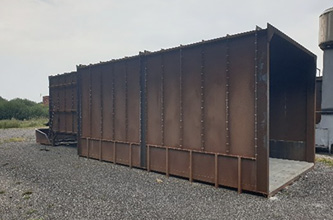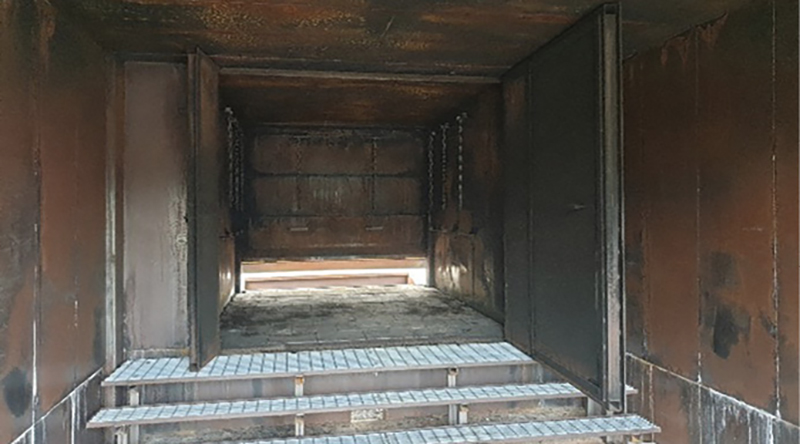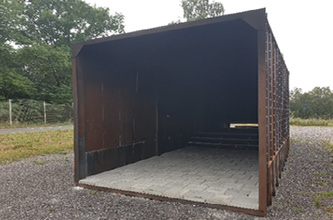By Stefan Svensson
In the early 1980s, the flashover container was developed by a couple of well-recognized and knowledgeable Swedish fire officers. It was an attempt to teach fire behavior more efficiently based on sound science. It became frequently used in the training of firefighters, and it wasn’t long until it found its way to other parts of the world. It has served us well over the years, and we have gained a huge amount of knowledge, especially how a more scientific view on fires can be useful to the fire service.
- Do You Know All That You Need to Know About Flashover?
- Flashover Survival
- Understanding Flashover
- Differentiating the “Fireground Phenomena”
Using the flashover container requires some unique skills of the instructor. If the instructor lacks these skills, experience, and a well-founded knowledge in fire behavior, the use of the flashover container soon becomes more of a way to intimidate the student or show off the instructor’s fire building skills and not a moment of education. Used in a wrong way, it might even be very dangerous. After all, there’s fire, temperature and heat flux are high, and conditions can change rapidly. Unfortunately, this seems to be happening frequently, and it’s almost as if it has become a spectacle—a moment of fear, an intimidation of the students. Stay inside, get some burns, be quiet, or be forever reminded of your weaknesses. In such cases, the instructor doesn’t instruct anymore. The instructor shows off.
Training firefighters and fire officers is not an easy task. You can have students with no experience whatsoever, and you can have students with several years of experience. Both groups can be very challenging, although in different ways. One of the most important starting points, however, is to always start from where the student is, not where the instructor is, in terms of knowledge. This is something we easily forget. In addition, education must always be dynamic and change over time, depending on, among other things, pedagogical development but not least because our knowledge in fire behavior increases and changes continuously. Science is a dynamic process, aiming at gaining more knowledge over time.
The training of Swedish firefighters and fire officers has changed a lot over the years. One of the more important changes has been to divide the training into smaller pieces before putting it all together.
Take, for example, the use of the flashover container. We have changed its name to the demonstration chamber, simply because that is exactly what it is. Its primary purpose is to demonstrate fire behavior in a room, not necessarily to induce flashovers. It’s not used for the training of suppression or the use of breathing apparatus. We demonstrate how fire grows and develops in an enclosure, and it’s a fairly undramatic event, especially since we have taken the student through a number of steps before arriving at the demonstration chamber.
- Attic Flashover: What’s Behind the Hidden Blast?
- THE VARIABLES OF FLASHOVER
- POTENTIAL FOR FLASHOVER OFTEN NOT RECOGNIZED
We don’t use a hoseline because it’s not needed—not even for safety, since it’s open, and if students for whatever reason feel uncomfortable, they can crawl out. Applying water might even make the situation worse. A second and more important reason for not using a hoseline is that it might confuse the students. The observation chamber is for demonstrating fire behavior; we have other training facilities for suppression. If the students don’t have a sufficient amount of knowledge in fire behavior, they will have a very hard time understanding fire suppression. Make it simple, and keep things separate.

(1) The fire demonstration chamber. (Photos by author.)

(2) The view from the observation chamber looking into the fire chamber. Note the doors separate the fire chamber from the student compartment, unlike the original design.

(3) The view looking in the open end of the observation chamber.
Before the Evolution
The first step is in the classroom, where we introduce the students to the terminology and a few basic concepts related to fire: stages of a room fire, fuel control, ventilation control, material properties, and so on. We demonstrate some of these concepts on a small scale (using video or actually burning things in a lab).
After that, we turn to burning small-scale models. Such models would then be scaled-down rooms. Already at this stage, the instructor will require some fairly advanced knowledge—scaling things down is not as simple as it sounds because of the characteristics of fire. Instead of making geometrical scaling only, we often have to consider things such as the ventilation factor—the relationship between the size of an opening and the surrounding surface area in a room, which has been proven to be an important relationship for how fire develops in a room. Depending on the purpose of a scale model, we have to consider different options for scaling.
Parallel to these first steps, we introduce the students to the breathing apparatus—how it works and its limitations; how the human body reacts to working with breathing apparatus, especially in high-heat conditions; and training in its use. After all, the breathing apparatus is our most important protection against many of the dangers we face in the fire service. This training process takes several days to work through, and there’s also continuous training throughout their education (basic education for becoming a career firefighter in Sweden is a two-year program). We need the students to feel comfortable as well as safe when using breathing apparatus.

(4) The side view of the fire demonstration chamber. Note the wider observation chamber to accommodate the opening of the burn chamber doors on the interior.
During the Evolution
When all of this is done and when the students are comfortable with their personal protective equipment, the concepts of fire behavior, terminology, and basic knowledge in how fire develops in a room, we bring them to the demonstration chamber. Before the session, although it is a fairly safe experience, we make sure the students understand what is expected. Apart from safety checks, the instructor describes, in detail, what will happen during the evolution, what to look for and look at, how fire will progress in the fuel used (usually fiberboard, which is wood only), the difference between training fuels and “real” fuels, how smoke will fill up the room and eventually ignite, and the impact of closing and opening a door to the compartment on fire. Again, this requires a knowledgeable, skilled, and experienced instructor.
During the evolution, the instructors don’t talk much. Instead, they point out what the students should look for at specific points in time. All the things mentioned above are pointed out before the evolution and are highlighted again after the evolution in the demonstration chamber. In many cases, the experience in the demonstration chamber makes the pulse rate go up, the students are fed by thousands of impressions, and there are plenty of distractions. Talking to them at the same time has shown to be yet another distraction, and we lose some of the learning experience.
Examples of what the instructors show the students (before, during, and after) include the following:
- Flame height: the difference between a flame in the corner and a flame at the center of a wall.
- Flames reaching the ceiling: how they bend, the increased levels of heat flux toward other surfaces (walls, floor), and the increase in rate of flame spread.
- Flame spread across walls and ceiling, depending on incident heat flux from flames.
- How pyrolysis of flammable material precedes the ignition.
- Formation of fire gases and the flow of fire gases out of the room and the flow of air into the room.
- Ignition of fire gases and the travel of flames.
- The sensation of temperature and heat flux toward the students.
- The impact of a closed door.
- The flow of smoke and air when the door is reopened.
- The ignition of the smoke after the door is opened.
After the Evolution
Afterward, the instructor talks it through with the students. Questions are asked and discussions are promoted. With some help from the instructor, the students are able to connect the pieces they learned during classes before the evolution. The puzzle becomes a picture—a dynamic picture.
Teaching fire behavior should be a nice journey for the students, a journey toward a higher level of knowledge and understanding, which we then use during more realistic operations training later during their education. It is not until after their training in the observation chamber that we start to introduce suppression and ventilation tactics. And, as with fire behavior, during these classes, we start very basic with theory and small-scale models before moving on to ful- scale training and more realistic scenarios.
Teaching fire behavior, or any other topic related to fire service operations, is a challenge, but we have to start where the students are—not where the instructor is. Otherwise, it soon turns into moments of intimidation and not education.
Stefan Svensson is an instructor at the Swedish Civil Contingencies Agency. He began his career as a firefighter in the Swedish Air Force in 1986. In 1989, he earned a bachelor’s degree in fire safety engineering and, in 2002, a Ph.D. at Lund University, Sweden. He has been a firefighter/crew commander at the local fire brigade for 15 years and is the regional on-scene commander for large incidents, including nuclear accidents. He is an associate professor at Lund University and since 1994 has been involved in experimental and theoretical investigations on firefighting tactics, including firefighting methods as well as problems of command and control. He is the author of several books, scientific articles, and reports.

